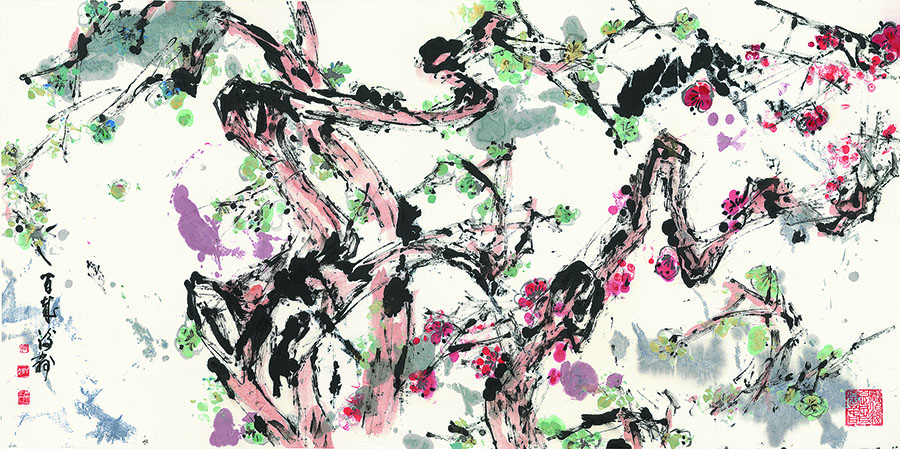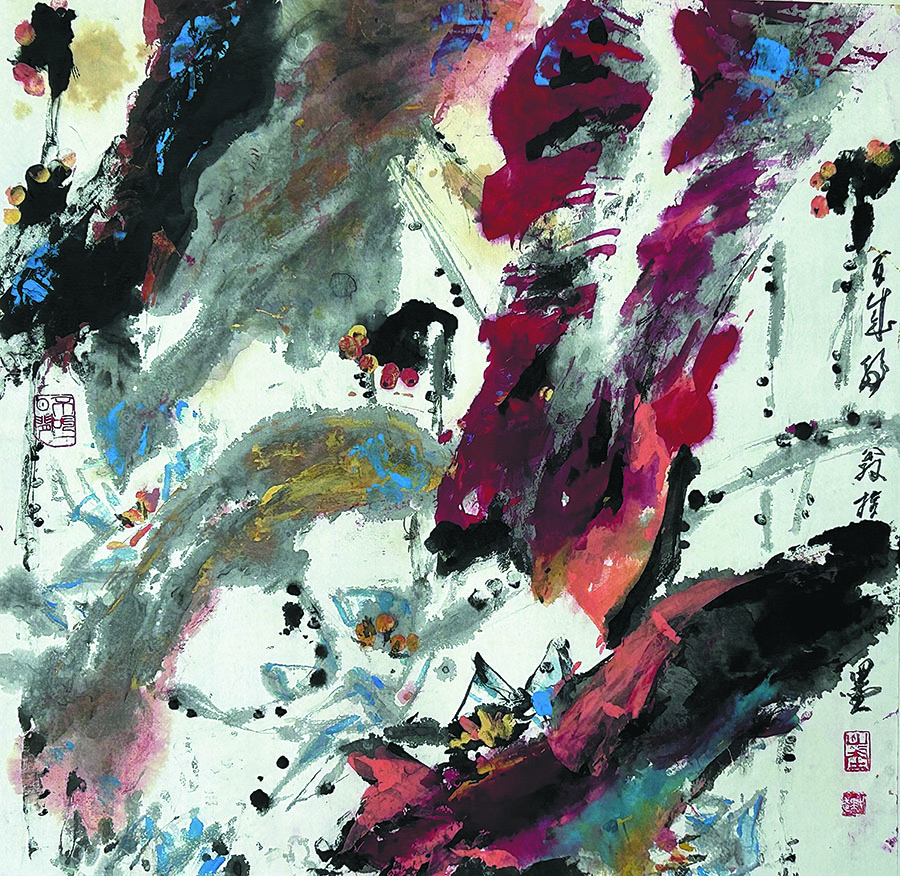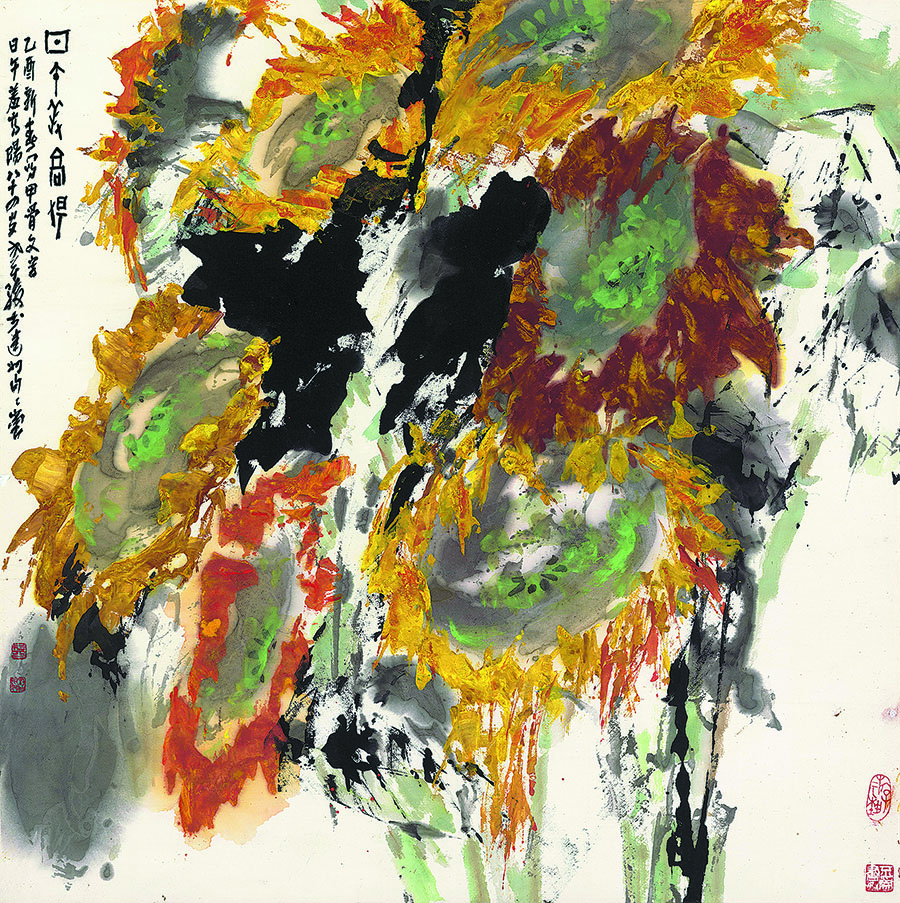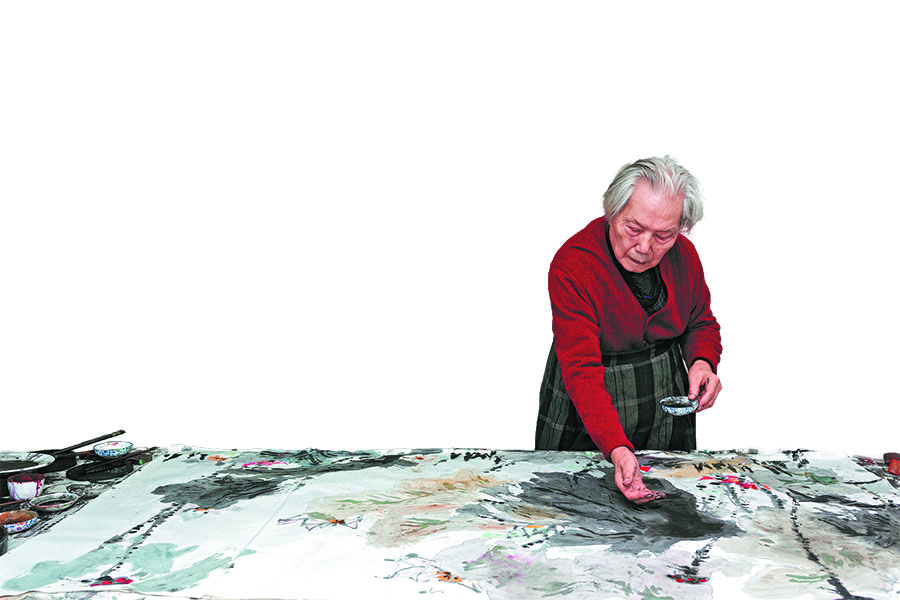A painter whose style continues to sing

Plums, a painting by the late artist Liu Bojun. A Gallop in the Galaxy of Colors, an exhibition in tribute to his endeavors in the realm of ink art over the last 80 years, is being held at the Art Museum of the Beijing Fine Art Academy, which runs until Sunday. [Photo provided to China Daily]
Vivid strokes of color are the immortal legacy of a centenarian master of ink, Lin Qi reports.
The secrets of longevity vary from person to person. For Liu Bojun, the ink artist who passed away in May at the age of 102, a positive attitude and an embrace of optimism and art were among the factors that ensured he endured through trials and tribulations.
Mostly living and working in his native Sichuan province, Liu gained a reputation in the realm of Chinese painting. He left an oeuvre in the flower-and-bird style of ink paintings, marked by their vibrant colors and vivid depictions done in the loose and carefree xieyi (literally "drawing spirit") approach to brushwork.
Liu continued to paint regularly into his late 90s, and even took up the brush earlier this year.

Untitled, another painting by Liu. [Photo provided to China Daily]
A Gallop in the Galaxy of Colors, a tribute to his endeavors in the realm of ink art over the last eight decades, is being held at the Art Museum of the Beijing Fine Art Academy through to Sunday. The paintings on show were primarily made by the artist in his 80s and 90s, but also include pieces painted during the final days of his life.
Hong Mei, the exhibition's curator and also associate professor at the Central Academy of Fine Arts, says Liu's accomplishments were closely associated with his investment in the zhihua (finger painting) style.
This particular style of painting is said to have been invented by Gao Qipei, a Qing Dynasty (1644-1911) court official and artist. Practitioners use their fingers, and sometimes the edges of their palms, to apply the ink.
Born into a cultured family, Liu learned the basics of Chinese painting and calligraphy from his well-versed parents and maternal uncles. In 1941, he enrolled at the National School of Fine Arts in Chongqing, where he began to train systematically in Chinese painting. He focused mainly on the flower-and-bird genre, and also developed interest in figure painting, and improved under the instruction of his headmaster Pan Tianshou and modern master of art, Lin Fengmian.
Hong says that Liu also made use of calligraphic ways of building up strokes, including the wild, uncommon and messy feeling of caoshu (cursive script), and the mood of power and dignity of lishu (clerical script), and xingshu (running script).

Sunflowers, featuring one of Liu's favorite subjects. [Photo provided to China Daily]
The use of a vivid and elegant spectrum of colors is another hallmark of Liu's work, Hong says, adding that the artist's palette encapsulates both the poetic atmosphere of the Chinese ink tradition and exploration with a modern touch, a highly expressive tendency he learned from Lin, who was among the first Chinese artists to study in France in the early 20th century.
The "Four Noble Ones" — the plum, orchid, bamboo and chrysanthemum — which symbolize integrity and good morals, are recurring motifs in Chinese painting, especially those painted by intellectuals.
While he also revisited these themes, Hong says that Liu replaced the chrysanthemum, which was a rare sight in Sichuan at the time, with the more common lotus flower.
Liu also developed innovative ways of depicting these plants. For example, when he drew plum trees, he skipped the more conventional horizontal and upward-looking perspectives. He chose an overlooking angle so that the tree branches look like dragons and phoenixes galloping across the universe, their blossoms almost animated.

A photo taken in 2011 shows Liu making a figure painting at his home in Chengdu, Sichuan province. [Photo provided to China Daily]
Furthermore, Liu created his own distinctive grouping of the "Four Common Ones" — the sunflower, cockscomb, canna lily and the peony — which he said were quite common in Sichuan and in which he felt the same spirit of positivity and persistence demonstrated by people at the grassroots.
At one point in the 1960s, Liu lived in a village near the Daba Mountains, where he saw many cockscombs growing around the farmhouses. With his strokes, he gave the plant a monumental feel that inspires respect. "Blooming in the fierce sunlight, cockscomb flowers remind me of the perseverance and the will to never succumb to hardship of my fellow Sichuan people," he once said.
Hong says that Liu toned down the intellectual, elite overtones of classic Chinese art, and lent it a more down-to-earth quality; the flowers in his work do not look proud or indifferent, but erupt with dynamism and vigor to touch the hearts of the public.
His reforms were his way of "practicing his teacher Pan's discipline that we should respect tradition, but not confine ourselves to the rules of painting", Hong says.
Liu Nanping, one of Liu Bojun's sons, says: "The exhibition contains the last artworks he left us and the world. They are the most beautiful melodies, which he sang with all his energy in the last moment of his life".
Related articles
-
 Ink paintings on show in Beijing to hail a new era
Ink paintings on show in Beijing to hail a new eraMore
-
 Brain Garden exhibition shows roots of creativity
Brain Garden exhibition shows roots of creativityMore
-
 Why is the design of GPA a good one
Why is the design of GPA a good oneMore
-
 Cultural Relics Forbidden to Be Exhibited Abroad - Tiaoxi Poetry Volume
Cultural Relics Forbidden to Be Exhibited Abroad - Tiaoxi Poetry VolumeMore
-
 Qi Baishi's Poetic Accomplishment Discussed at Academy's Annual Meeting
Qi Baishi's Poetic Accomplishment Discussed at Academy's Annual MeetingMore
-
 Farmers paint a brighter future for themselves
Farmers paint a brighter future for themselvesMore
